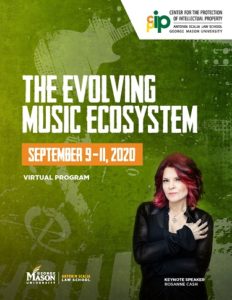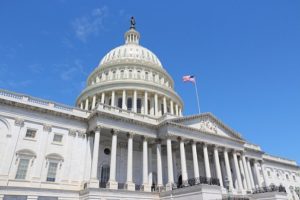The following post comes from Meghan Carlin, who is in her second year at Osgoode Hall Law School in Toronto, Ontario. In addition to her work with the IPilogue, Meghan is a Fellow with the Innovation Clinic and is Co-President of the Osgoode Entertainment and Sports Law Association. This post first appeared at IPilogue.
 By Meghan Carlin
By Meghan Carlin
The ongoing history of sound recording rights continues to provide a fascinating study in the United States’ copyright regime’s ability to contemplate and absorb new technologies into its framework. The evolution of these rights in America over the last 50 years charts alongside the country’s evolving music industry, crystallizing the importance, and distinctiveness, of music law in relation to the broader copyright regime.
Over the last 20 years, global music industry players have seen traditional revenue streams decrease as the shift towards digital distribution has intensified. In 2018, reported global revenues from recorded music were 25% lower than those reported in 1999 – without adjusting for nearly 20 years of inflation. With the worldwide concert industry grinding to a halt, removing a major source of revenue for performers and copyright owners alike, the effect of COVID-19 on the global music industry has placed a spotlight on moving the conversation on sound recording rights forward.
On September 9th through 11th, 2020, the Center for the Protection of Intellectual Property (CPIP) hosted The Evolving Music Ecosystem conference. Streaming online from George Mason University Antonin Scalia Law School in Arlington, Virginia, day one of the conference saw panelists tackling a number of topics in music law, including the colourful history of sound recording rights in America and their current status under the US copyright regime. The below provides a deeper look at the issues discussed during the Changing Nature of Sound Recording Rights panel on September 9th.
Looking Back: The Music Modernization Act
Revenues from recorded music have grown over the last five years in the US, with the Recording Industry Association of America (RIAA) reporting four years in a row of double-digit growth. In 2019, revenues from recorded music grew 13%, primarily through paid subscription services. Total revenues from streaming alone grew 19.9% in 2019, accounting for almost 80% of all recorded music revenues in the United States.
Consider these statistics against the legislative backdrop that governs the payment of royalties for recorded music. On October 11, 2018, the Orrin G. Hatch-Bob Goodlatte Music Modernization Act (H.R. 1551) (“MMA”) was signed into law by President Donald Trump. The MMA combines three previously introduced bills intended to modernize copyright law as it relates to the music industry.
Title I of the MMA is the Musical Works Modernization Act, which impacts the conversation on sound recording rights in a number of ways. First, Title I changes the standard used by the Copyright Royalty Board (“CRB”) in setting digital royalty rates, bringing the standard used for digital radio stations up to date. Under the old regime, the standard used for setting statutory royalties relied on public interest considerations, preventing the CRB from considering what a licensee might pay as a market rate. Under the MMA, the rates for all compulsory blanket licences are to be determined through a market-based standard, sometimes referred to as a willing buyer/willing seller standard, ideally creating a fairer standard of compensation for the owners of sound recordings.
Further, Title I establishes the Mechanical Licensing Collective (MLC). While the primary role of the MLC is to collect and distribute section 115 mechanical publishing royalties, it has also been tasked with the creation of a Musical Works Database, intended to link sound recordings to their underlying compositions. In theory, the database will provide music users with a one-stop shop for uncovering all potential rightsholders involved in a song, on both the sound recording and the composition side.
Title II of the MMA tackles the grey zone inhabited by pre-1972 recording artists, otherwise known as “legacy artists”. The Classics Protection and Access Act extends the same protections to the digital public performance of pre-1972 sound recordings as those extended to post-1972 recordings. The practical outcome of this legislation? Digital radio stations and streaming services are now responsible for paying royalties for the expansive catalogue of pre-1972 recordings in their repertoires, according to the uniform rate setting standard outlined in Title I.
Title III, The AMP (Allocation for Music Producers) Act, creates a new “letter of direction” process, allowing recording artists to distribute a portion of the royalties collected for a sound recording to the producers, sound engineers or mixers involved in its production. Title III enables SoundExchange, the entity collecting and distributing sound recording royalties under section 114 statutory licenses, to distribute these royalties directly to the producers involved on behalf of recording artists who submit a “letter of direction” outlining their intention to make such a payment.
Simply put, and as it currently stands, the US legislation regarding sound recording rights maintains its focus on digital plays. What about analog?
Looking Forward: AM-FM Act
The AM-FM (Ask Musicians For Music) Act, introduced to Congress in November 2019, is a bi-partisan bill aimed at creating a terrestrial radio (AM/FM) performance right for sound recordings. The AM-FM Act arrives following the Fair Pay for Fair Play Act, introduced in both 2015 and 2017 with the same goal, but which failed to pass.
Supporters of the AM-FM Act describe it as ending a “a decades-long loophole” stemming back to the early days of radio that has allowed AM-FM radio broadcasters to play recorded music on air without obtaining the permission of the recording’s copyright owner, and without paying royalties for the use. In essence, it is argued, terrestrial radio broadcasters are being subsidized by the recording industry and will continue to be until the creation of an AM-FM radio performance right in sound recordings.
The National Association of Broadcasters has come out in opposition of the AM-FM Act, countering with their support of the Local Radio Freedom Act, stating that “Congress should not impose any new performance fee, tax, royalty, or other charge relating to the public performance of sound recordings on a local radio station for broadcasting sound recordings over the air, or on any business for the public performance of sound recordings on a local radio station broadcast over the air”.
In contemplating the ongoing battle over the creation of a terrestrial broadcast performance right in sound recordings, we’re provided with the opportunity to consider the role of analog radio in a digital era, and to think through the questions of promotion versus consumption that relate to music copyright as a whole.
Today: CUSMA
One argument made by proponents of the AM-FM Act is that while countries with a terrestrial radio performance right for sound recordings collect royalties for American artists whose sound recordings are played outside the US, they are unable to pass on these royalties to US rights holders as there is no domestic royalty scheme. In written comments filed in February 2020 in response to the USTR’s Request for Comments and Notice of Public Hearing Regarding the 2020 Special 301 Review, SoundExchange identified 6 territories which deny full national treatment to American recording artists – UK, France, Australia, Japan, the Netherlands, and Canada.
On July 1, 2020, the Canada-United States-Mexico Agreement (CUSMA) entered into force in Canada, providing full national treatment to sound recordings. Chapter 20 on intellectual property rights states at Article 20.8 that “in respect of all categories of intellectual property covered in this Chapter, each Party shall accord to nationals of another Party treatment no less favorable than it accords to its own nationals with regard to the protection of intellectual property rights”. As explained by panelist and Attorney Eric Schwartz of Mitchell Silberberg & Knupp, Canada’s implementation of its CUSMA obligation to give national treatment to sound recordings is sure to result in new payments to American copyright owners for uses occurring in Canada.
The effect of COVID-19 on the worldwide music industry has put the focus on the copyright regime’s ability to respond to change, both cultural and technological. For those interested in music law, and in the modernization of copyright more generally, the complicated and curious history of sound recording rights provides countless jumping off points for creatively thinking through the issues affecting artists and copyright holders today.
 By David Ward
By David Ward